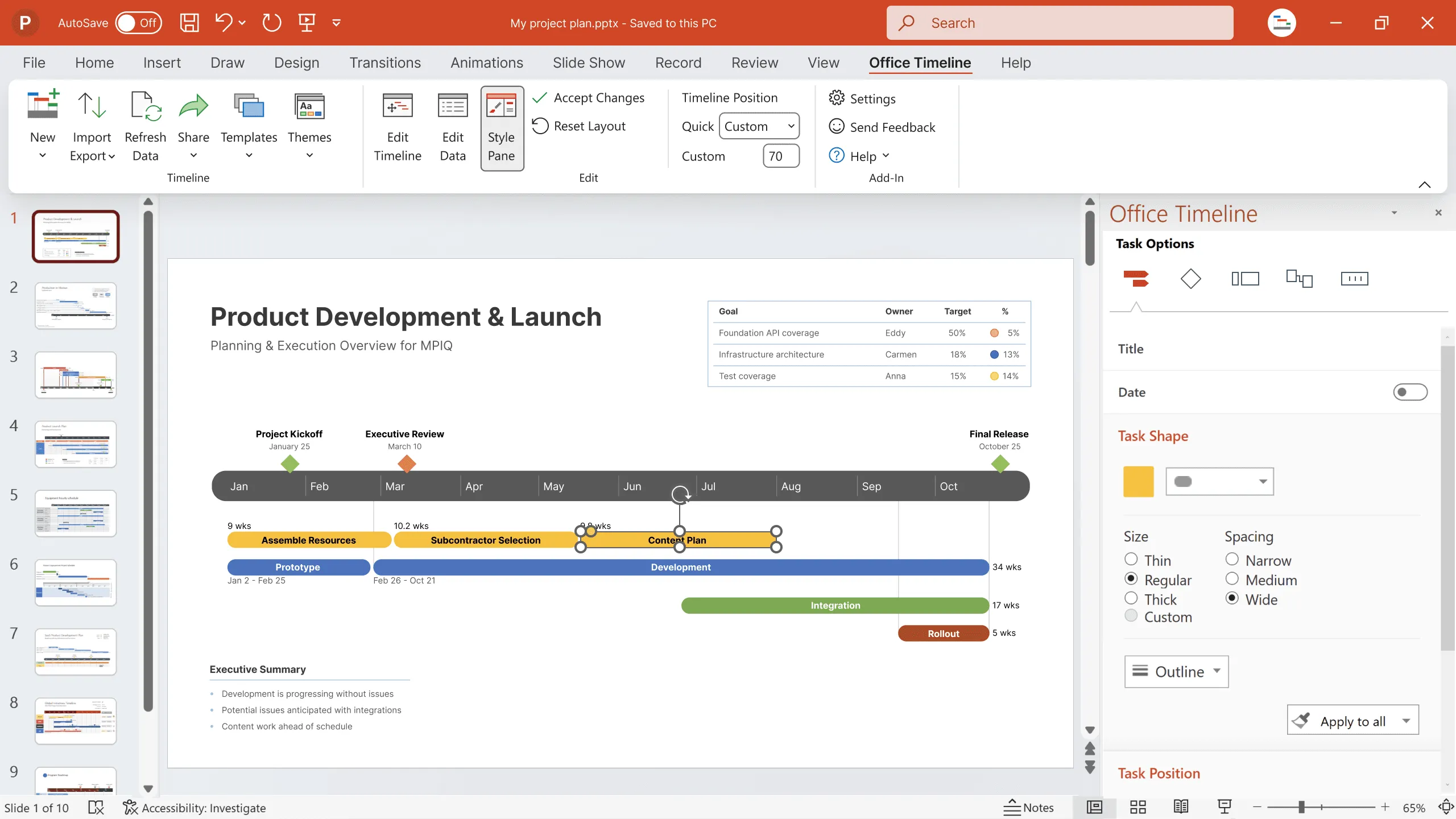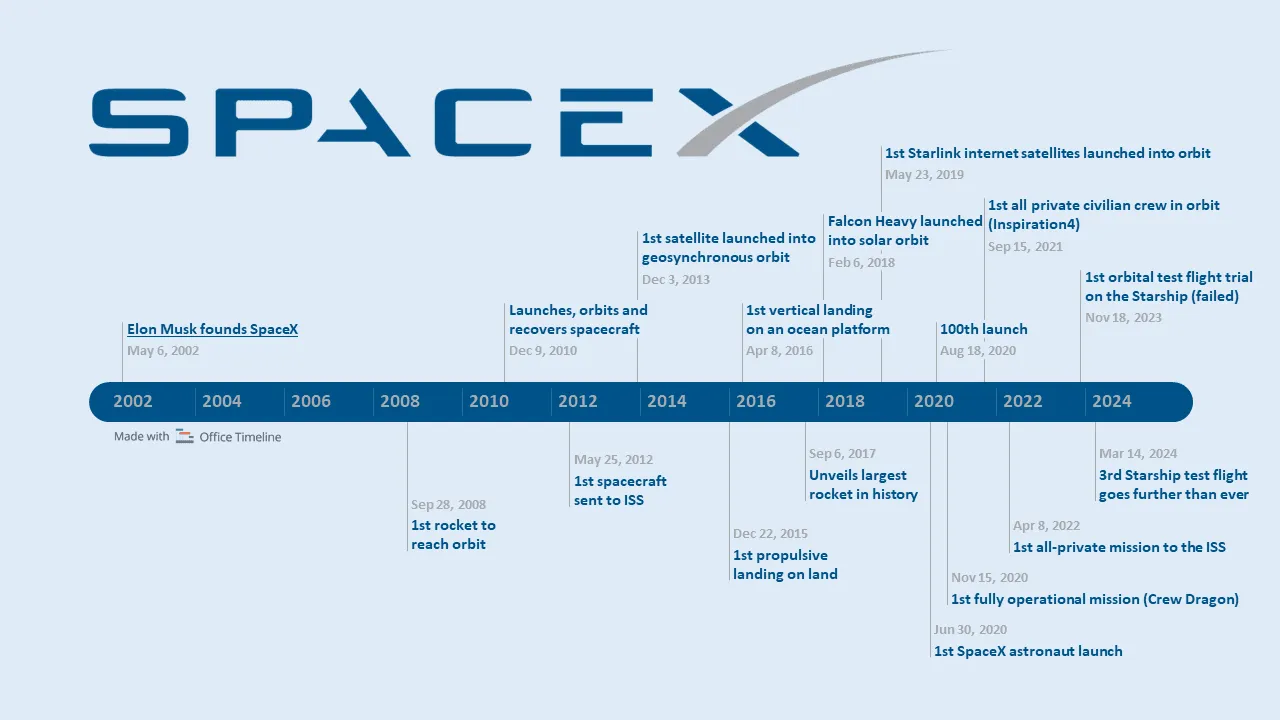SpaceX timeline: Sky’s the limit
Take off into the cosmos with our SpaceX timeline! Explore the highs and lows of interstellar exploration as we chart SpaceX's journey to the stars.
Last updated on: March 20, 2024
Embark on a journey to the stars with our SpaceX timeline, a visual account of the company’s most important historical milestones and world records achieved. We’ll take a look at both the successes and setbacks they’ve experienced along the way and try to answer some of the most rocket fuel-burning questions you may have.
Created using Office Timeline, our time-travel capable PowerPoint add-in, this timeline celebrates humanity’s first steps into privately owned interstellar exploration.
3… 2… 1… We have lift off!
SpaceX: key milestones
Let’s have a look at the most important milestones placed on the SpaceX timeline.
- May 6, 2002: Elon Musk founds SpaceX
- September 28, 2008: 1st rocket to reach orbit
- December 9, 2010: Launches, orbits and recovers spacecraft
- May 25, 2012: 1st spacecraft sent to ISS
- December 3, 2013: 1st satellite launched into geosynchronous orbit
- December 22, 2015: 1st propulsive landing on land
- April 8, 2016: 1st vertical landing on an ocean platform
- September 6, 2016: Announces Interplanetary Transport System program
- January 6, 2017: 1st Hyperloop Competition
- March 30, 2017 1st orbital rocket reused
- June 3, 2017: 1st re-flight of a commercial cargo spacecraft
- September 6, 2017: Unveils largest rocket in history
- February 6, 2018: Falcon Heavy launched into solar orbit
- May 23, 2019: 1st Starlink internet satellites launched into orbit
- June 30, 2020: 1st SpaceX astronaut launch
- August 18, 2020: 100th launch
- November 15, 2020: 1st fully operational mission (on the Crew Dragon)
- September 15, 2021: 1st all private civilian crew in orbit (Inspiration4)
- April 8, 2022: 1st all-private mission to the ISS
- November 18, 2023: 1st orbital test flight trial on the Starship (failed)
- March 14, 2024: 3rd Starship test flight reaches further than ever
Origins of SpaceX
The Space Exploration Technologies Corp., or SpaceX for short, was founded by Elon Musk in 2002, as part of his dream to colonize Mars. Owning the company that produces the rockets wasn’t originally part of Musk’s Mars terraforming plan; the billionaire visited the Russian space Agency in 2001, hoping to secure a contract with Roscosmos for the use of their space rockets.
However, he was greeted with a hostile attitude, which culminated with one Russian engineer spitting on Musk’s shoes. During the journey home, Elon Musk had an epiphany: he could avoid purchasing expensive Russian-made solutions by establishing his own rocket manufacturing company. Around one year later, SpaceX was born.
As Lori Garver, a former NASA Deputy Administrator, puts it: “If Helen of Troy had a face that launched a thousand ships, this was the spit that launched a thousand spaceships”. The mindboggling story is confirmed by another prime mover in the SpaceX program, Jim Cantrell.
SpaceX’s first steps
SpaceX wasn’t an immediate success, by any means. In fact, the first three rockets launched between 2006 and 2008 didn’t make it into orbit. The first Falcon 1 suffered a fuel leak that resulted in a fire, while the following two encountered issues following the separation of the boosters. As a result, the company was close to bankruptcy. Musk was also experiencing financial difficulties with Tesla around this time.
Everything was riding on the fourth launch attempt. With almost no engineering updates to the rocket from the previous failed version (except a slightly increased timeframe between the first stage burnout and the second stage separation), failure seemed imminent. But, as Musk puts it “[…] fate liked us that day” and the Falcon 1 became the very first privately owned rocket to make it into the Earth’s orbit.
The Dragon and the ISS
The success allowed SpaceX to focus on the development of a new, larger and heavier rocket named the Falcon 9. NASA’s help here was invaluable and accelerated the project considerably. The gambit proved successful. In 2012, the Dragon became the very first privately owned commercial spacecraft to deliver shipments to the ISS. This triumph nearly doubled SpaceX’s private equity valuation.
Eight years later, on May 30, 2020, the Crew Dragon (launched using the Falcon 9) marked the first manned orbital SpaceX flight. The pioneers were astronauts Doug Hurley and Bob Behnken. Following the launch, NASA certified the Falcon 9 and its Crew Dragon shuttle for flights to and from the ISS. It meant that the space agency was no longer dependent on the Russian Soyuz rockets for the transportation of American astronauts to and from the station.
The Roadster and the Starman
The date is February 6, 2018, and we are outside Launch Pad 39A at the Kennedy Space Center. The largest and most advanced rocket – the Falcon Heavy – stands 23 stories tall on its 27 engines, that are about to fire in unison, producing over 5 million lbs of thrust force. Buzz Aldrin is among the 100,000 spectators in attendance. The Falcon Heavy would be launched from the very same pad as his 1969 moon flight.
On board the Falcon Heavy, the payload of the test flight consists of Musk’s own Tesla convertible. In the driver’s seat, a mannequin named “Starman” (referencing Bowie’s eponymous hit song) donning a spacesuit is waiting with its right hand on the wheel and the left resting lazily out the window. The glovebox compartment contains a copy of “The Hitchhiker’s Guide to the Galaxy” by Douglas Adams and towel, for emergencies.
3… 2… 1… Blast off! The Falcon Heavy launches successfully and the three components of Musk’s new reusable rocket return to Earth, two landing at the Cape Canaveral Air Force Station and the third in the Atlantic Ocean. For those wondering about the fate of the Tesla and its Starman passenger, they’re still travelling through our solar system even today. In fact, you can track their position via this convenient website.
Starlink satellites
The Falcon Heavy flight was a test conducted to determine the feasibility of putting satellites into orbit. Its success allowed SpaceX to develop its Starlink network of thousands of satellites providing internet to over 2.4 million users, as of 2024. Starlink played a pivotal role in the beginning of the Russian-Ukrainian conflict, offering Ukrainian troops internet access in remote areas where connectivity was limited.
Inspiration4 and the first civilian space flight
Floating inside the Crew Dragon Resilience module mounted atop the Falcon 9 rocket, billionaire Jared Isaacman accompanied by Sian Proctor, Hayley Arceneaux and Christopher Sembroksi became the first civilian passengers to go into space without any professional astronauts on board. While not everyone was overly excited about making the one-percenters the first private citizens in orbit, the initiative managed to raise over $243m in donations for St. Jude Children’s Research hospital.
Frequently asked questions about SpaceX
Let’s explore some of the most frequently asked questions about SpaceX and its history.
SpaceX is the very first private company to build rockets that have managed to achieve orbital flight. They are also the only capable of returning spacecrafts from low orbit, with other notable achievements including the delivery of cargo (2012) and astronauts (2021) to the International Space Station (ISS). Their goals include reducing the costs of space travel and ultimately making it more accessible by creating reusable rocket technology.
The first 2-stage reusable rocket capable of orbital flight measures 70 meters (229.6 feet) in height and 3.7 meters (12 feet) in diameter. It weighs 549,054 kilograms (1,207,920 pounds). The Falcon 9 uses Merlin engines and it’s capable of achieving a 845 Kilonewtons (190,000 pound feet) thrust.
After two unsuccessful test flights in March 2007 and August 2008, SpaceX’s Falcon 1 reached orbit in September 2008. This achievement made them the very first privately owned company to send a liquid fuel rocket into orbit and secured them a Nasa contract for servicing the ISS, worth over $1bn.
Elon Musk is the founder (2002) and current owner of SpaceX (Space Exploration Technologies Corp). It is not listed with major stock exchanges or Nasdaq, meaning that you cannot purchase shares via brokerage accounts. Musk retains between 40% and 50% of the shares, while the staff and venture capital investors (Founders Fund, Fidelity Investments, Google Ventures, Valor Equity Partners, etc.) control the rest.
The California-based company handles spacecraft manufacturing, launching services, and satellite communication (via the Starlink subsidiary). They are also listed as a defense contractor for the United States.
Starlink – a subsidiary of SpaceX – is a network of thousands of low-orbiting satellites that have been launched using the mother company’s rockets. These satellites bounce signals between themselves and ground stations, whereby providing high-speed broadband internet connectivity.
SpaceX is credited as the very first developer of reusable rocket technology. Prior to the Falcon 9, their first spacecraft of this type, rockets would normally be designed for single use. After the delivery of the payload, they would either burn up upon atmosphere re-entry or suffer a controlled crash into the ocean. The SpaceX innovations that made it possible to reuse rockets (in part) consist of engines that can be used in both launching and landing, as well the development of superior lightweight and heat-resistant materials.
About the SpaceX timeline
The SpaceX timeline is free to download and it was created using Office Timeline, a powerful and easy to use add-in for PowerPoint that can significantly streamline the process of creating amazing visuals for your next presentation. Check out the free 14-day trial and see what it can do firsthand.
Tim is Co-Founder & CEO of Office Timeline, a Seattle-based start-up that aims to rid the world of boring, uninspiring meetings.
Turn project data into professional timelines
Get the advanced features of Office Timeline free for 14 days.



